The Best Salad Spinners, Tested and Reviewed
Dotdash Meredith and Yahoo Inc. may earn commission or revenue on some items through the links below.
Spin your way to clean salad greens.
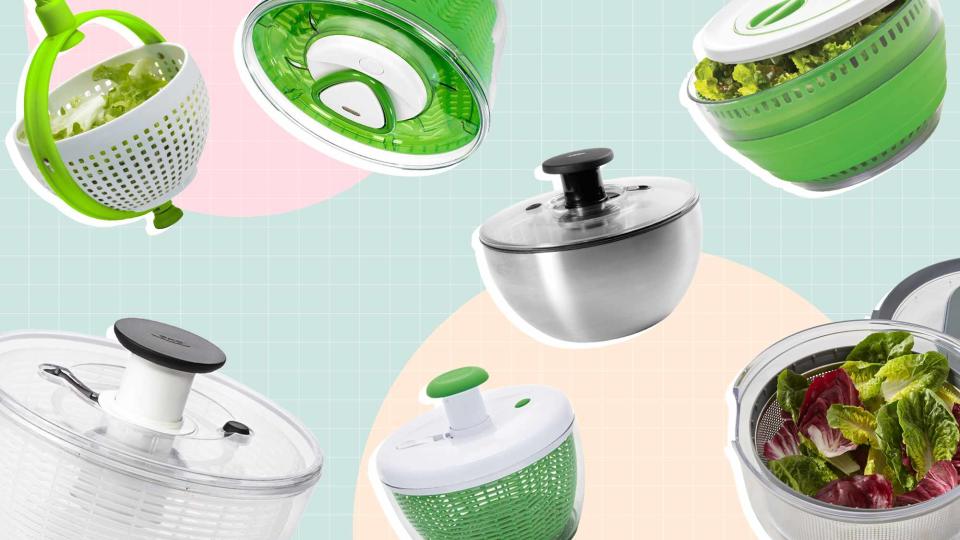
For most of my adult life, I’ve been a Salad Girl. I firmly believe that, paired with the right ingredients, a bowl of mixed greens can be just as satisfying as a plate of pasta. However, there’s one thing that has historically prevented me from making my salads at home (and, in turn, caused me to spend way too much on pre-made salads at restaurants)—and that is all the work involved in washing and prepping the greens.
First and foremost, you have to thoroughly rinse the greens in a bowl of water to remove any dirt and contaminants. Then, you’ll have to locate a colander and drain the water—and, unless you enjoy wet lettuce (I don’t), you’ll need to remove the remaining moisture from the leaves by patting them dry with a towel (or several). If you’re like me, this entire process takes forever and turns your kitchen countertop into a swimming pool.
So, roughly three years ago, I bought my very first salad spinner—and, not to be dramatic, but it has changed my life. This seemingly simple kitchen gadget not only makes easy work of washing and drying leafy veggies, from romaine to radicchio, but it also doubles as a colander, a serving bowl and much more. Suffice it to say that my salad spinner is one of the best purchases I’ve made for my kitchen in recent years.
But with all the salad spinners on the market nowadays—from pump to crank and beyond—it can be tricky to find the best one for you. With this in mind, I rounded up several popular salad spinners and gave them a (literal) whirl in my home kitchen to see how they performed. (You’re welcome, by the way.) After putting them all through the wringer, I’ve concluded that these are the ones you want in your kitchen.
Our Salad Spinner Recommendations
Best Overall: OXO Good Grips Salad Spinner
Also Great: ZYLISS Easy Spin Salad Spinner
Best Large-Capacity: Farberware Salad Spinner
Best High-End: Williams Sonoma Stainless Steel Salad Spinner
Best for Small Spaces: PrepWorks Collapsible Salad Spinner
Best Overall: OXO Good Grips Salad Spinner
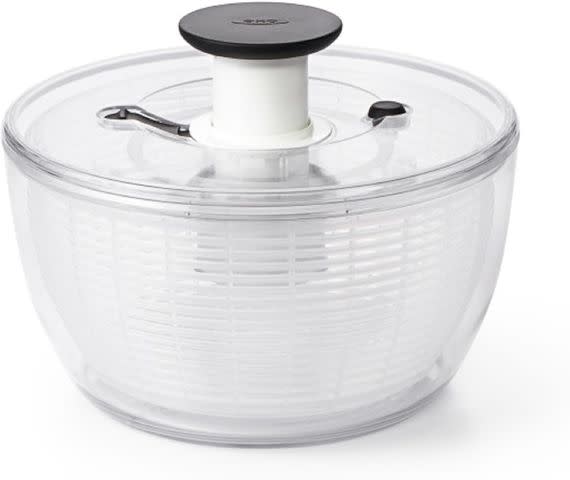
Amazon
What we like: With its ample capacity, approachable price point, sturdy design and user-friendly pump-style spinning mechanism, this model checks all the boxes.
What to know: It can be prone to discoloration.
Spoiler alert: This OXO Good Grips Salad Spinner was, indeed, the aforementioned “life-changing” inaugural salad spinner purchase I made years ago. Over the three years I’ve had it, it has consistently performed better than almost any other salad spinner I’ve tried—and for $30, it’s also one of the most affordable. (Our writer Kristin Montemarano also loves this OXO salad spinner, so it’s got multiple fans on the EatingWell team.) Here are a few reasons why we love it.
First of all, this thing is quite capacious, with a capacity of over 6 quarts. It consists of a thick and sturdy clear plastic bowl with a plastic colander-style basket that sits inside it and a pump-style lid that collapses for easier storage. A rubberized ring along the bottom of the bowl helps keep it from slipping and sliding on the counter as you spin. To top it off, the individual pieces of the spinner can serve multiple purposes—the inner basket can double as a colander, and the outer bowl can double as a serving bowl, a mixing bowl or even a dough-proofing bowl.
Using this salad spinner really couldn’t be any easier. Start by rinsing your greens of choice and placing them into the basket (or, if you’re like me, rinse them in the basket). Then, place the basket of greens inside the bowl, put the lid on top and push down on the pump button to start spinning. (This thing stays in one spot pretty well, so I can operate it with only one hand.) To stop, simply press the small black “brake” button beside the pump. If you’d like to collapse the pump, press it all the way down and push in the black plastic tab to the right. When you’re finished using the spinner, you can toss the whole thing into the dishwasher for easy cleanup.
My only minor complaint with this spinner is that it can be prone to staining—particularly the rubberized ring on the bottom. A little backstory: After using my OXO salad spinner one day, I placed it in my sink to wash later. However, I didn’t realize there was a pan already sitting and soaking at the bottom of the sink—and that pan happened to be caked with residue from a bright red gochujang-based dish I had cooked earlier. Long story short, the rubberized bottom of my OXO salad spinner bowl now has a faint reddish stain that I can’t seem to remove. So, if you choose this spinner, maybe keep it away from stain-inducing foods—you’ll thank me later.
Size: 10.5"D x 10.5"W x 6"H | Capacity: 6.22 quarts | Material: Plastic | Spinning Mechanism: Pump | Dishwasher Safe? Yes
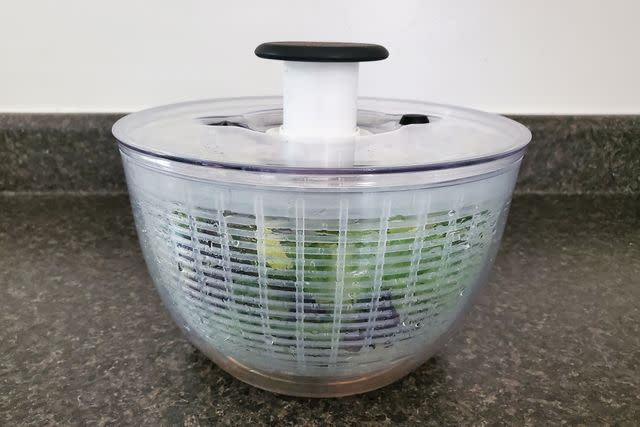
EatingWell / Kayleigh Drake
Also Great: ZYLISS Easy Spin Salad Spinner
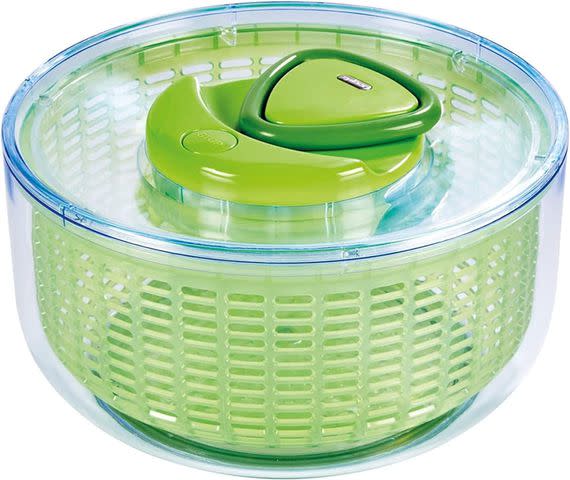
Amazon
What we like: Another sturdy and roomy option, this ZYLISS spinner is fun to use thanks to its pull-cord spinning mechanism.
What to know: The lid tends to move around a lot when pulling the cord, so you’ll need to steady it with your other hand.
This ZYLISS Easy Spin Salad Spinner is another solid option in the salad spinner space. Like the OXO, it consists of a sturdy plastic bowl with a colander-style basket inside and a plastic lid on top. It’s nearly as large as the aforementioned OXO, and although the exact capacity isn’t specified, trust me when I say that you can fit a lot of greens inside this thing.
One thing I find interesting and unique about this ZYLISS spinner is its mode of operation. Whereas most other salad spinners I’ve tried have either a pump or a hand-crank spinning method, this one has a pull-cord mechanism. On the lid, you'll find a triangular-shaped handle, which reveals a rope-like retractable cord when you pull it. This acts as the “torque” to spin the basket inside the device.
When I tested the ZYLISS, I honestly found it quite fun to operate—it reminded me of cranking a lawn mower (if you know, you know). However, the force exerted when I pulled the cord caused the lid to move out of place, so I needed to use both hands with this device (one to pull the cord and the other to hold down the lid). That said, I liked that the rubber bottom of the bowl kept it from jumping around on the counter as it did its thing.
When it comes to cleaning this salad spinner, the manufacturer says the bowl is dishwasher safe. But in the name of testing, I also threw the basket in the top rack of the dishwasher, and it came out just fine. The lid, however, should definitely be hand-washed, as putting it in the dishwasher could damage the cord mechanism and render the spinning function useless.
Size: 10.1”D x 10.1”W x 5.65”H | Capacity: N/A | Material: Plastic | Spinning Mechanism: Pull-cord | Dishwasher Safe? Yes (bowl only)
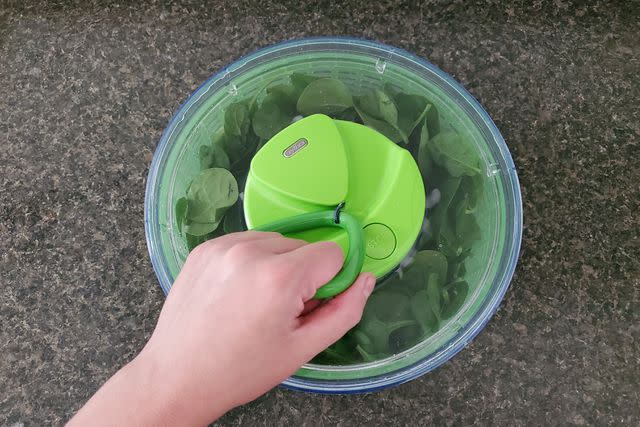
EatingWell / Kayleigh Drake
Best Large-Capacity: Farberware Salad Spinner
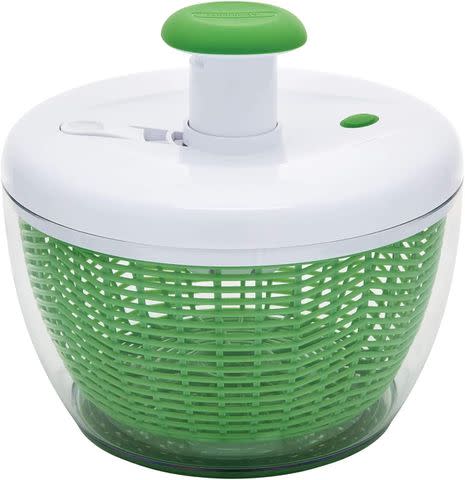
Amazon
What we like: This large salad spinner fits over six-and-a-half quarts of greens.
What to know: It moves around a bit while spinning, and it’s a little bulky to store.
If you’ve got a lot of greens to clean, this machine works like a dream. With a capacity of 6.6 quarts, this Farberware model is the roomiest salad spinner out of the six I tested, so if you’re spinning salad for a crowd, this is the one you want.
This spinner is very similar to the OXO spinner in terms of design and operation. The Farberware comprises a clear plastic bowl, a lightweight green plastic basket, and a collapsible pump-style lid that fits very securely on top of the bowl. Simply push down on the pump to start the spinner and push the green brake button on the lid to stop it. When it’s time to collapse the lid, press the pump down and slide the white plastic tab to the left to secure it.
When I tried out this spinner, it got the majority of the water off of the greens; I gave it an additional spin to remove the small amount of remaining moisture, which worked like a charm. While this Farberware spinner was just as easy to operate as the OXO, the speed of the spinning basket caused the device to vibrate and “hop around” on the counter a good bit. Because of this, I had to use one hand to steady the bowl while I pressed the pump with the other. It's not a huge deal overall, but you likely won’t be able to multitask while using this spinner.
Due to the size of this Farberware spinner, it’s a little bulky to store, so you’ll want to make sure you’ve got the space for it. However, since the pump is collapsible, it takes up a little less room than it would otherwise. The brand recommends hand-washing this salad spinner, but I decided to rebel against authority and throw the bowl and basket into the dishwasher (top rack, I’ll add, with no high-heat drying cycle). The bowl came out just fine, but the basket had some very slight warping when I first took it out of the dishwasher. Luckily, I could give it a light squeeze and return it to its original shape.
Size: 10.31"L x 10.31"W x 7.44"H | Capacity: 6.6 quarts | Material: Plastic | Spinning Mechanism: Pump | Dishwasher Safe? Yes
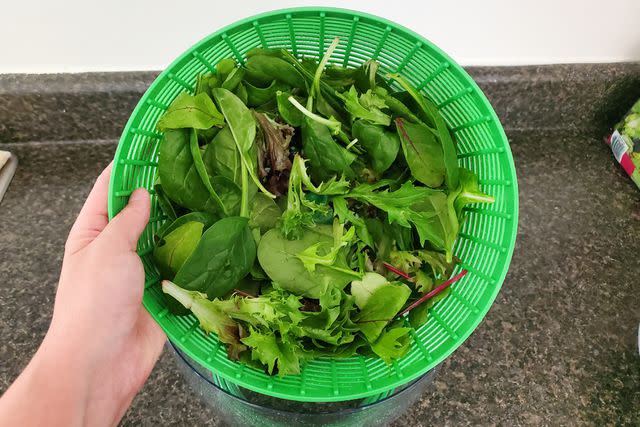
EatingWell / Kayleigh Drake
Best High-End: Williams Sonoma Stainless Steel Salad Spinner
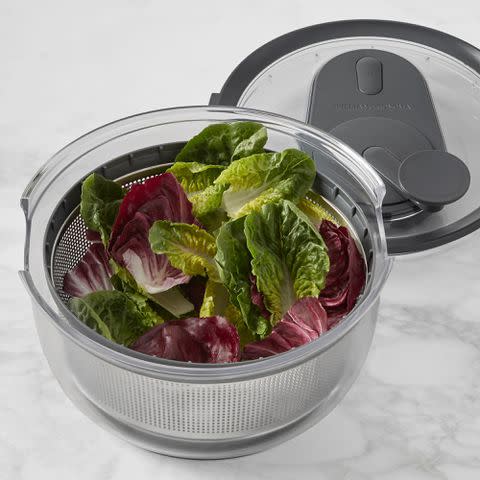
Williams Sonoma
What we like: This elegant salad spinner features a stainless steel bowl and is sturdier than any other spinner I've tested.
What to know: It costs nearly three times as much as the other options on our list.
Designed exclusively for Williams Sonoma, this sleek, stately salad spinner makes an excellent luxury buy and an attractive statement piece for your countertop. It features a crank-style lid and a thick, sturdy plastic bowl with a stainless steel basket inside. The bowl has U-shaped divots on the sides, which allow the lid to lock into place for a secure fit. And thanks to its nonslip base, this spinner stayed in one spot the entire time I spun my salads.
I loved the look and feel of the handle on the lid, and I could operate the crank with just one hand. The holes in the basket are very small, which makes this device ideal for spinning tiny-leafed veggies like alfalfa sprouts or microgreens. I used this Williams Sonoma model to spin a chopped salad mix consisting of diced cabbage, cilantro, scallions, shredded carrots and celery, and the small pieces all stayed right inside the basket—no stray bits slipping through the cracks here. When it’s time to stop your salad from spinning, press the fittingly labeled “stop” button right above the handle.
As far as cleaning goes, Williams Sonoma states that the stainless steel basket is dishwasher-safe, but the lid and the bowl should be washed by hand. Since it should be clear by now that I’m a bender of rules in the name of science, I also washed the bowl and lid in the dishwasher (but made sure to put them on the top rack and avoid any high-heat drying cycles). Everything made it out of the dishwasher just fine, although quite a bit of water got trapped inside the lid, which required me to shake the living daylights out of it to remove the excess moisture. (Looking back, this is likely one of the reasons the brand recommends hand-washing it. You live and you learn, right?)
Overall, this Williams Sonoma model was by far the sturdiest and definitely the prettiest salad spinner I tested. The only caveat? It costs $100, nearly three times more expensive than any other option on our list. But if you’re up for the splurge, I think this spinner is worth the money.
Size: 11”D x 11”W x 6.5”H | Capacity: 4 quarts | Material: Plastic, stainless steel | Spinning Mechanism: Crank | Dishwasher Safe? Yes (basket only)
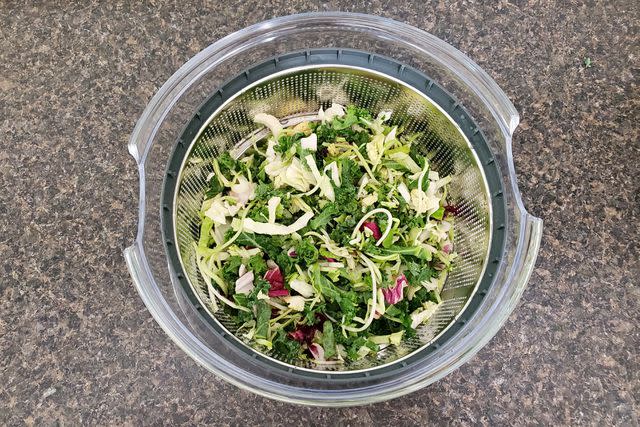
EatingWell / Kayleigh Drake
Best for Small Spaces: PrepWorks Collapsible Salad Spinner
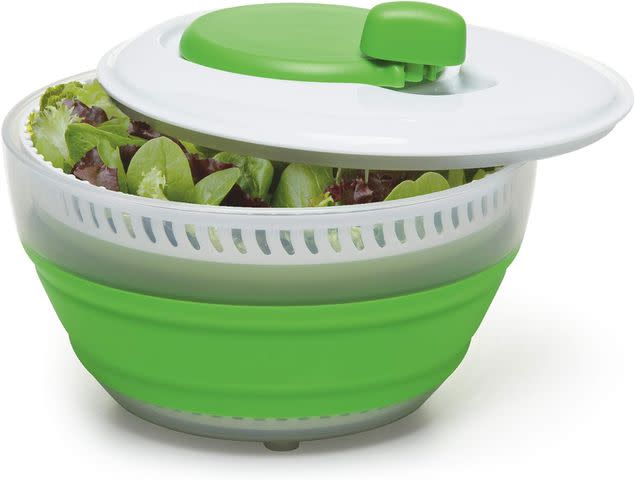
Amazon
What we like: This petite, collapsible salad spinner is a cinch to store in tight quarters.
What to know: It only holds 3 quarts worth of greens.
If you live in a dorm or a small apartment, or if you share a kitchen with multiple roommates, this PrepWorks salad spinner is a great space-saving pick. It measures less than 10 inches in diameter, and its collapsible design means it takes up less room than a box of cereal.
This spinner uses a crank-style mode of operation, and you can turn it both clockwise and counterclockwise when spinning your greens. (In fact, turning it both ways helps sling off even more water from the leaves.) This PrepWorks model doesn’t have a brake button like most other spinners on this list, but when you’re ready to stop the spinning, squeeze the silicone sides of the bowl, and it’ll come right to a halt.
All pieces of this spinner—the bowl, basket and lid—are dishwasher-safe for fuss-free cleaning, and while I did have to shake the lid a bit to get the water out of the nooks and crannies, it dried pretty quickly. When you’re ready to collapse the spinner, grab both sides of the bowl and push down, which will fold the silicone band in on itself. (You’ll do the same for the basket, too.) When both pieces are collapsed, place the basket inside the folds of the bowl, put the lid on top and slide the whole thing right into storage.
One thing to note about this spinner is that it only holds 3 quarts of greens due to its petite size. While this may not be an issue if you’re cooking for one, it may be a bit inconvenient if you’ve got a lot of greens to clean. Another thing I’ll point out: The slits at the bottom of the basket are a bit wide, so this may not be the best option for spinning smaller greens, as the pieces can easily slip through the cracks.
Size: 9”D x 9”W x 4”H | Capacity: 3 quarts | Material: Plastic, silicone | Spinning Mechanism: Crank | Dishwasher Safe? Yes
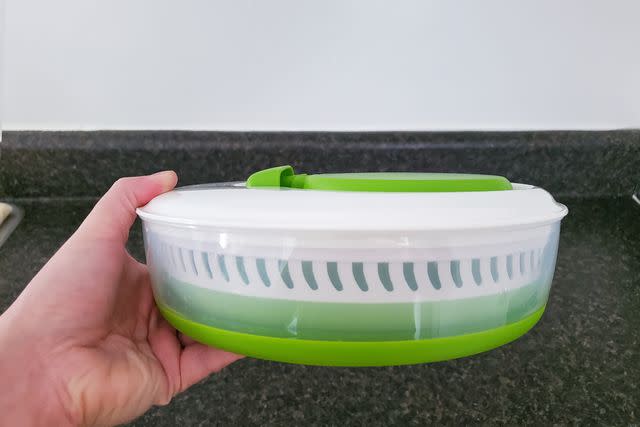
EatingWell / Kayleigh Drake
The Bottom Line: The Best Salad Spinners
If you’re looking for a great all-around salad spinner at an approachable price point, I don’t think you can do much better than the OXO Good Grips Salad Spinner (view at Amazon). Its user-friendly pump-based design is super easy to operate, and it does a great job of flinging moisture off of any greens you put into it. If you’re up for the splurge, though, the Williams Sonoma Stainless Steel Salad Spinner (view at Williams Sonoma) is an absolute dream to use—and it looks gorgeous on your countertop, too!
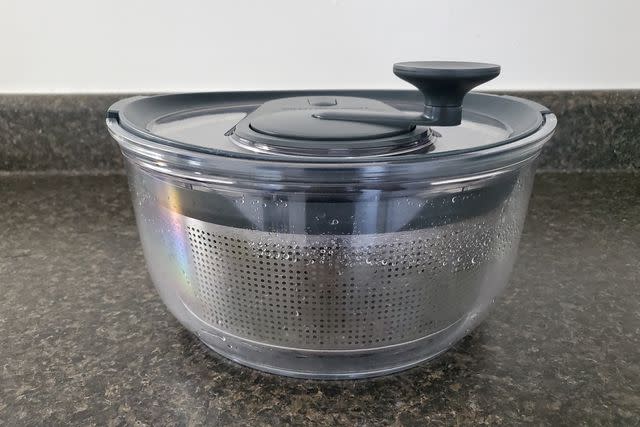
EatingWell / Kayleigh Drake
Choosing a Salad Spinner
Keep the following points in mind as you're shopping for salad spinners:
How Big Is It?
First and foremost, you’ll want to choose a salad spinner that’s large enough for your needs. If you primarily cook for one, or if you live in a smaller space and don’t have a ton of storage, you may opt for a smaller spinner such as the PrepWorks (which is collapsible, by the way!). On the flip side, if you have more mouths to feed or if you prefer washing your greens in bulk, a larger spinner might be ideal for you.
What's It Made Of?
While the majority of the salad spinners in our list are made of plastic, there are some models that incorporate other materials, like stainless steel and silicone. You can even find glass salad spinners on the market, too—in fact, the OXO spinner on our list comes in a glass version (as well as a stainless steel version). While these materials often raise the price of the spinner, they may also mean the spinner is more durable or dishwasher-safe.
How Do You Operate It?
This all comes down to personal preference and how much elbow grease you want to exert when spinning your salads. While every spinner on our list involves some degree of manual operation, there are several spinning methods you can choose from. There’s the “pump” method, which involves pushing a button on the lid to spin your greens, and a hand-crank method that operates similarly to a manual car window. Other models, including the ZYLISS on our list, have a pull-cord mechanism that gives you a mini arm workout as you spin. Determining your preferred method will help you narrow your options within the salad spinner space.
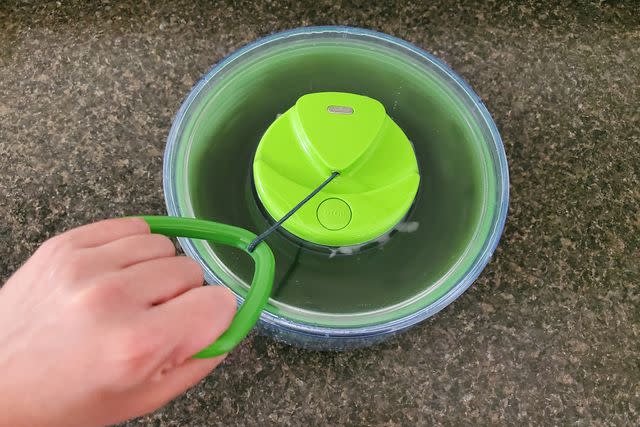
EatingWell / Kayleigh Drake
Our Salad Spinner Tests
For this article, I tested six salad spinners. I spun a variety of greens, from spinach to romaine to chopped cabbage mixes, in the spinners to gauge how each handled different types of produce. After washing and spinning the leaves, I observed how much water remained on them.
I also noted any flaws or “quirks” in the operation of each spinner: Does it slide around on the counter or stay in one spot? Does the lid stay securely in place, or is it a bit loosey-goosey? Do you need both hands to use the spinner? Do you have to perform magic spells to get it to spin correctly? Things of that nature.
I then washed each spinner according to the manufacturer’s instructions (taking a few “creative detours” of my own in the name of testing) and evaluated how easy or tedious it was. Finally, I considered each spinner's overall value before ranking them in various categories for the final list.
We Also Considered
Dreamfarm Spina Spin and Strain Colander ($35 at Amazon): I do like what Spina was going for with this one: It’s essentially a colander with a handle that you can rotate on its axis to turn the whole thing into a salad spinner. However, the design is too quirky to be functional, in my experience. First, there’s no outer bowl to catch the water, so you’ll have to either spin the greens in your sink (gross) or equip your countertop with lots of towels to sop up the water that will inevitably spew out of the basket during the spinning process. It also doesn’t have a lid, so there’s nothing to keep the greens from flying out of the basket while they spin. Because of these design factors, I had to operate the spinner very gingerly so as to not spill my greens everywhere, so it didn’t remove much water from them. Furthermore, the basket is relatively small, and I couldn’t fit many greens in there for fear of spillage. All things considered, I think the $35 you pay for this thing would be better used on one of the other spinners.
Common Questions
What is a salad spinner, exactly?
As their name implies, salad spinners are gadgets designed for spinning salad greens to remove moisture from the leaves. Not only does this help prevent soggy, wet lettuce in your salads, but it also helps keep the leaves crisp and fresh in the fridge. (Excess moisture on leafy vegetables is an express ticket to a slimy mess.) Salad spinners come in handy if you plan to sauté vegetables like spinach or kale, as they help prevent the dreaded “crackle and pop” of moisture hitting the hot oil in your pan.
How do you use a salad spinner?
Most salad spinners have three main components: a lid, a colander and an outer bowl. To use a salad spinner, you’ll start by rinsing the produce and placing it in the colander before fitting it into the outer bowl. For greens that need a quick rinse, you can simply run water over them in the colander. For sandy or dirty greens (looking at you, spinach), put the greens in the colander inside the outer bowl, fill with water, agitate the greens with your hand and let the dirt sink to the bottom. Empty and repeat as necessary until the water runs clean.
From there, you’ll attach the lid and spin the greens with whatever motion is required for the specific model (e.g., pump, crank, etc.). Most salad spinners also include a “brake” of some sort, which is usually a button that you can press to stop the machine's movement. Once your greens are spun, check for any lingering water. If your greens are still damp, you may need to fluff them and spin them again to shake off the excess moisture.
What are the different types of salad spinners?
Before you give your greens a whirl, it's important to understand the differences in the available models. While they all achieve the same end result (dry greens), there are multiple modes of operation. The three main types of spinners are a pump-based spinner, a crank-based spinner and a pull-cord-based spinner.
A pump-based spinner operates like a plunger, where the downward movement causes the machine to spin. A crank-based spinner typically includes a handle that needs to be constantly turned to create the spinning motion. Finally, a pull-cord-based spinner works similarly to a lawn mower—you’ll pull a retractable cord out to create torque and start the machine.
What's the best way to clean a salad spinner?
How you clean your salad spinner will largely depend on the specific model you choose and what the manufacturer’s instructions recommend. In many cases, you can wash the bowl and basket in the dishwasher (often on the top rack), while you’ll likely need to wash the lid by hand. Some models recommend hand-washing the entire thing, though, so it’s important to read the manual before subjecting your spinner to the high heat and harsh chemicals of a dishwasher.
What else can you use a salad spinner for?
While a salad spinner might seem like a single-use kitchen gadget, it can perform multiple tasks in the kitchen (depending on the model, of course). For instance, the basket of the OXO Good Grips Salad Spinner (our top overall choice) can double as a colander or strainer for draining pasta or rinsing produce. Meanwhile, the bowl can serve as a mixing bowl, a serving bowl or a dough-proofing bowl—the possibilities are endless!
Our Trusted Expertise
Kayleigh Drake is a former EatingWell commerce editor and contributor to publications including Food & Wine, The Spruce Eats and Verywell Fit. She personally tested all six of the salad spinners in this article, using them to spin everything from romaine to spinach to frisée (and enjoying quite a few delicious salads along the way). She is also the proud owner of an OXO Good Grips Salad Spinner, aka our Best Overall pick in this roundup, and she uses it more than almost any other specialty gadget in her kitchen.
An earlier version of this article was written by EatingWell’s associate food editor Alex Loh, and this updated version still contains some of her original reporting.
This article was edited by Katie Tuttle, a commerce editor and contributor to publications such as Food & Wine and The Spruce Eats.
Read the original article on Eating Well.

